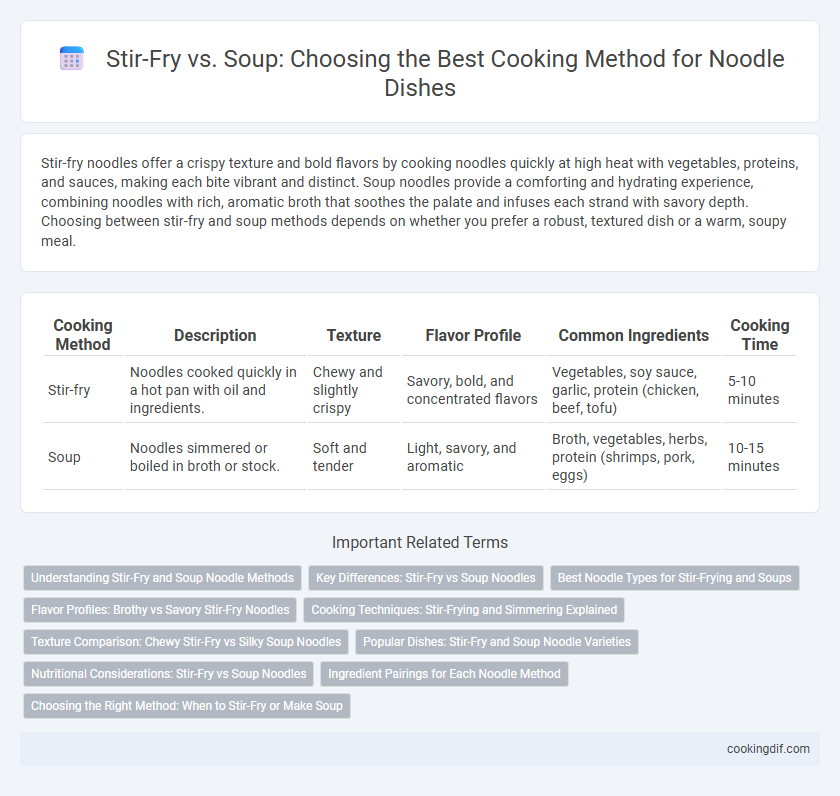Stir-fry noodles offer a crispy texture and bold flavors by cooking noodles quickly at high heat with vegetables, proteins, and sauces, making each bite vibrant and distinct. Soup noodles provide a comforting and hydrating experience, combining noodles with rich, aromatic broth that soothes the palate and infuses each strand with savory depth. Choosing between stir-fry and soup methods depends on whether you prefer a robust, textured dish or a warm, soupy meal.
Table of Comparison
| Cooking Method | Description | Texture | Flavor Profile | Common Ingredients | Cooking Time |
|---|---|---|---|---|---|
| Stir-fry | Noodles cooked quickly in a hot pan with oil and ingredients. | Chewy and slightly crispy | Savory, bold, and concentrated flavors | Vegetables, soy sauce, garlic, protein (chicken, beef, tofu) | 5-10 minutes |
| Soup | Noodles simmered or boiled in broth or stock. | Soft and tender | Light, savory, and aromatic | Broth, vegetables, herbs, protein (shrimps, pork, eggs) | 10-15 minutes |
Understanding Stir-Fry and Soup Noodle Methods
Stir-fry noodle cooking involves quickly cooking noodles with high heat, often combined with vegetables, protein, and flavorful sauces to create a savory, well-textured dish. Soup noodle methods submerge noodles in a rich, aromatic broth, allowing flavors to meld and produce a comforting, liquid-based meal with tender noodles. Both techniques highlight distinct textural and taste profiles, catering to diverse culinary preferences and regional traditions.
Key Differences: Stir-Fry vs Soup Noodles
Stir-fry noodles involve cooking noodles quickly at high heat with vegetables, proteins, and sauces, creating a dry, flavorful dish with distinct textures. Soup noodles are prepared by boiling noodles and serving them in a rich broth, emphasizing warmth and depth of flavor with a more liquid base. Key differences lie in cooking techniques, moisture content, and flavor profile, with stir-fry offering a crispy, savory experience, while soup noodles provide comfort through aromatic, soupy consistency.
Best Noodle Types for Stir-Frying and Soups
For stir-frying, firm and slightly thicker noodle varieties like lo mein, udon, and rice sticks hold their texture well without becoming mushy, making them ideal for absorbing savory sauces. In contrast, delicate and thin noodles such as vermicelli, soba, and ramen excel in soups, as their lightness allows them to soak up rich broths quickly while maintaining a tender bite. Choosing the right noodle variety enhances the dish's flavor balance and textural harmony, crucial for both stir-fry and soup preparations.
Flavor Profiles: Brothy vs Savory Stir-Fry Noodles
Stir-fry noodles develop a rich, umami-packed flavor from soy sauce, garlic, and sesame oil, creating a savory, caramelized profile with a satisfying texture. In contrast, noodle soups emphasize a lighter, brothy flavor, often infused with aromatic herbs, spices, and slow-simmered stocks that deliver warmth and depth. The choice between stir-fry and soup affects both the mouthfeel and the intensity of seasoning, catering to different flavor preferences.
Cooking Techniques: Stir-Frying and Simmering Explained
Stir-frying noodles involves high heat and constant tossing, which quickly cooks the noodles while preserving their texture and allowing them to absorb bold flavors from sauces and spices. Simmering noodles in soup requires gentle, prolonged cooking in broth, infusing the noodles with moisture and savory depth while creating a harmonious blend of ingredients. Both techniques highlight distinct culinary qualities: stir-frying emphasizes crispness and concentrated seasoning, whereas simmering enhances tenderness and rich flavor integration.
Texture Comparison: Chewy Stir-Fry vs Silky Soup Noodles
Stir-fry noodles achieve a chewy texture due to high-heat cooking that quickly sears the noodles while preserving firmness and bite. Soup noodles offer a silky, smooth mouthfeel as they absorb broth, becoming tender and pliable without losing structural integrity. The choice between stir-fry and soup noodles hinges on desired texture, with stir-fry highlighting resilience and soup emphasizing softness.
Popular Dishes: Stir-Fry and Soup Noodle Varieties
Stir-fry noodles like Pad Thai and Chow Mein offer a savory, crispy texture with vegetables and proteins quickly cooked over high heat. Soup noodles such as Pho and Ramen provide a rich, aromatic broth that infuses the noodles with deep flavor and warmth. Both cooking methods highlight distinct regional ingredients and culinary traditions, making them popular choices in Asian cuisine.
Nutritional Considerations: Stir-Fry vs Soup Noodles
Stir-fry noodles typically retain more nutrients due to shorter cooking times and the use of fresh vegetables and lean proteins, which enhances fiber and protein content. In contrast, soup noodles may have higher sodium levels from broths and can lose some water-soluble vitamins during boiling. Choosing between stir-fry and soup noodle dishes depends on balancing nutrient retention with hydration and flavor preferences.
Ingredient Pairings for Each Noodle Method
Stir-fry noodles excel with ingredients like crisp vegetables, marinated meats, and flavorful sauces that clings to each strand, enhancing texture and taste. Soup-based noodles benefit from rich broths infused with aromatics like ginger, garlic, and green onions, complemented by tender proteins and fresh herbs that meld harmoniously. Both methods offer distinctive ingredient pairings that elevate the noodle experience through contrasting cooking techniques and flavor profiles.
Choosing the Right Method: When to Stir-Fry or Make Soup
Stir-frying noodles enhances texture and flavor by quickly cooking ingredients on high heat, ideal for crisp vegetables and proteins. Soup-based noodles offer a comforting, warming dish where flavors meld slowly, perfect for broths rich in umami and aromatic spices. Selecting the method depends on desired taste profile, cooking time, and ingredient compatibility to achieve optimal noodle dish satisfaction.
Stir-fry vs soup for noodle cooking method Infographic

 cookingdif.com
cookingdif.com